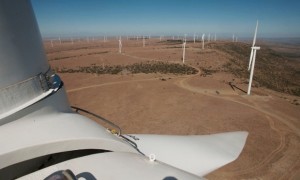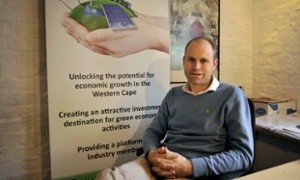Solar, biomass and wind energy systems are popping up all over the country and feeding clean energy into the strained electrical grid.

The howling wind drives the turbines, their blades bent back from the force as they spin in the evening light and send electricity to local villages in South Africa’s Eastern Cape.
High up on the top of the turbine, local resident Lungela Vongu, dressed in a safety harness and hard hat leans far out over the 100 meter drop to check that the wind speed detector is working properly. “This wind farm is bringing a lot more jobs into this community for the people, without it there is no future here,” he says.
The Cookhouse wind farm is the biggest wind system built in Africa, with 66 turbines generating 138MW of clean power. It started feeding the grid at the end of 2014 and it is far from unique.
Although still heavily dependent on fossil fuels, South Africa has been quietly creating one of the world’s most progressive alternative energy plans. Solar, biomass and wind energy systems are popping up all over the country and feeding clean energy into the strained electrical grid.
“It is set to completely transform these deep rural communities in terms of healthcare, education, job creation and a raft of other interventions. All this while putting green electricity on the grid at affordable prices,” said Johan van den Berg, director of the South African Wind Energy Association.
Like all the projects in the country a percentage of the equity of the Cookhouse wind farm is held by the Cookhouse community trust. The trustees come from the local community and they funnel the profits of 15% of the sale of the energy into health care, education and job creation.
But it is low price for the electricity that is really making the difference. Wind energy from new projects now costs 5 US cents per kWh, roughly half the cost of new coal.
Renewable energy has a long way to go to overtake South Africa’s reliance on coal though. It is number 11 in the world for total CO2 output from energy use and the fifth largest producer of the climate-changing fossil fuel.
The situation seems poised to get worse as construction continues on Medupi, the largest dry cooled coal-fired power station in the world.
Meant to be completed by 2013, the station has been mired in delays and cost overruns since construction first started in 2007.
Meanwhile, wind power has been quietly piling on capacity. Tina Joemat-Pettersson, the South African minister of energy said in a recent speech that the country has added a total of 4,322MW of renewable energy capacity in less than four years.
Medupi, whenever it is finished, is designed to supply 4,764MW.
That renewables have almost surpassed the output of such a station in about half the time of it’s still-unfinished construction is a testament to the government’s commitment to alternative energy, the maturity of the technology and the work of hundreds of companies, organisations and partnering governments.
“In the last 16 years the best way to describe it is that it’s a rocket launch after a very slow countdown,” says van den Berg.
The government is still pursuing other energy types with a plan to open up 20% of the country to shale gas fracking and a controversial deal set up by President Jacob Zuma in 2014 to buy eight new nuclear power plants from Russia for $84bn. But van den Berg sees a step change for renewables.
“For the first decade of working in climate change I felt like we were rearranging the deck chairs on a sinking ship and making no real impact.”
“In my heart of hearts, I wasn’t convinced there was a technical solution, renewable energy wasn’t as yet affordable. Today, all of that has changed.”
It’s not only power that is flowing from the 79 licensed projects underway in the country, the South Africa’s Department of Energy reports that $16.8bn has been injected into the country’s economic infrastructure through the various projects.
The numbers have piqued the interest of big traditional energy companies like Exxaro. The company produces 39m tons of coal per year to feed the world’s hunger for energy, but they are now poised to break ground on a $300m wind energy project in the Eastern Cape.

“What we are seeing is not only is the technology producing much cleaner power but it’s doing so at a lower cost than traditional fossil fuel technologies,” said Evan Rice, chief executive of Greencape, in Cape Town, a government funded not-for-profit development agency.
Three years ago they assisted the city of Cape Town and the national government to partner with Germany to create the South African Renewable Energy Technology Centre in the city’s suburbs. The cutting-edge technology centre will produce around 250 qualified technicians a year to run and maintain the renewable energy systems in the country.
A $30m wind tower factory has just been finished outside Cape Town by European multinational GRI Renewable Industries in the township of Atlantis. The area has been severely economically depressed and the massive 12,000 square meter factory will directly employ 200 people building 150 South African wind towers per year. Rice says many more jobs will come as production ramps up.
“On the continent, there really is the opportunity to leapfrog the old centralised large scale fossil fuel power and big grid paradigm. With technology and project prices continuing to drop, and rapid breakthroughs in battery and other storage technologies, I have no doubt that renewables will address all of our power needs in time. This will happen sooner than people think,” he said.